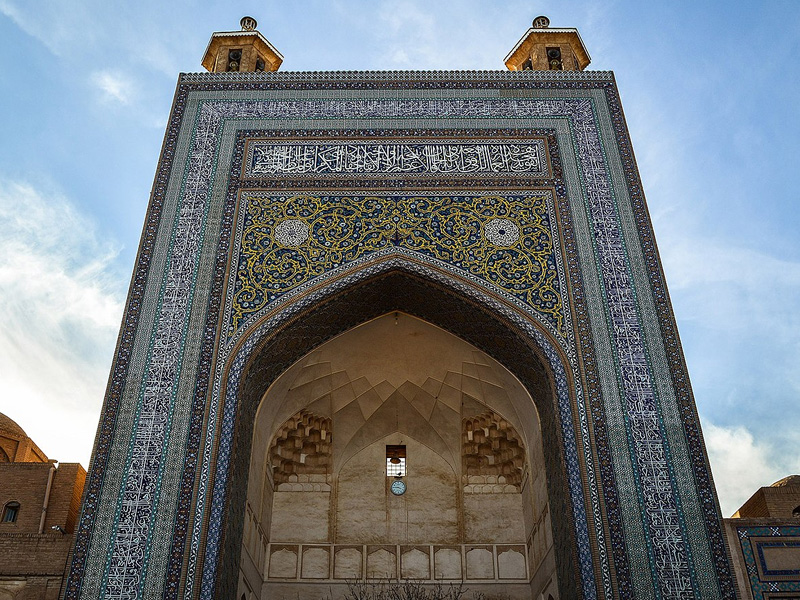The Tomb of Sheikh Ahmad Jami is one of the prominent Iranian mausoleums located in Torbat-e Jam County, Razavi Khorasan Province. It is recognized as one of the important pilgrimage and religious centers in the region. Sheikh Ahmad Jami was a renowned figure in Iran and is known as one of the distinguished scholars. The mausoleum serves as a place of visitation, and visitors traveling to Torbat-e Jam can see this historical and valuable site. In this article, Eligasht intends to introduce this historical mausoleum and its surrounding attractions.
Book Iran Air flights from London to Tehran and Tehran to London with Eligasht UK:
Who is Sheikh Ahmad Jami?
Sheikh Ahmad Jami was born in 1049 AD in Nameq Village, Koohsorkh County, Razavi Khorasan. He was unemployed until the age of 22 when he decided to change his path and turned towards religion. He spent about 12 years of his life in worship in the mountains around Nameq Village. Then he went to Torbat-e Jam, settled in Bazd Village, and built a mosque called “Masjid-e Noor” at the foot of the mountain of the same name, which still exists.
Throughout his life, Sheikh Jami traveled to various cities, including Neishabur, Herat, Buzjan, Marv, and Bastam, and became acquainted with the scholars of Khorasan. During his journey to Torbat-e Jam, he built a Khanqah (Sufi monastery) in Ma’dabad Village, which served as the place for writing books and training his disciples. After that, his fame spread throughout the city, capturing the attention of the rulers, and he became known as one of the great figures of Iran.
The Tomb of Sheikh Ahmad Jami
The Tomb of Sheikh Ahmad Jami, a Khorasani Sufi and Iranian poet, is located on the route from Mashhad to Herat and is known as Torbat-e Jam due to his burial in this area. Ahmad Jami, also known as Abunasr Ahmad Zhendepil, lived in the 5th and 6th centuries of the Hijri lunar calendar and is considered one of the prominent scholars and mystics of that period. He was born in Nameq (Kashmar) and his tomb is located in Deh-e Ma’dabad, near Jami. This pilgrimage site has attracted the attention of visitors and researchers due to its valuable historical and architectural structures dating back to different centuries, including the 7th to the 13th centuries of the Hijri calendar.
History of the Tomb of Jami
Sheikh Ahmad Jami, known as “Abu Nasr Ahmad Zhendepil” or simply “Zhendepil,” was one of the great mystics and Sufis of the Seljuk period, who lived from 536 to 440 AH. After the death of Ahmad Jami, his disciples, some of whom were rulers and political leaders, built beautiful and valuable structures around his tomb as a sign of their devotion and respect for him. These structures include mosques, schools, hospices, and other facilities related to the shrine of Sheikh Ahmad Jami, including a hospice and a mosque located next to his burial place. This act demonstrates the importance and status he held in the hearts of the people and his disciples, as the shrine of Sheikh Ahmad Jami has become one of the important religious and pilgrimage destinations in Iran to this day.
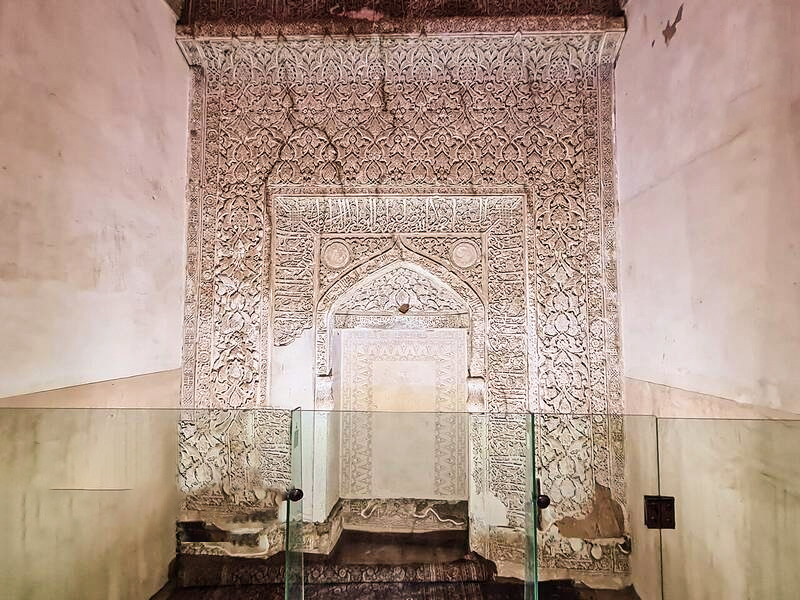
Architecture of the Tomb of Ahmad Jami
One prominent and attractive part of the Tomb of Sheikh Ahmad Jami is its entrance, which dates back to the 8th century AH. The entrance of this tomb is adorned with wooden plaques inscribed with Kufic script, but unfortunately, due to the deterioration of some of them, it is not possible to read the inscriptions completely. After that, we reach the entrance section of the tomb, which is designed with bricks and decorated with different ornaments from various periods. For example, during the Ilkhanid period, it was adorned with white plaster, and in later periods, it was decorated with plasterwork and red color.
Another part of this complex includes a water reservoir, an underground mosque, and graves located near the mausoleum. The view of Sheikh Ahmad Jami’s mausoleum is very beautiful and pleasant, with an enclosed area surrounded by a white and black marble fence, and a large pistachio tree inside it. This tree is a symbol of life and eternity and is considered a sign of the eternal memory of Sheikh Ahmad Jami. The stones of this mausoleum have numerous inscriptions written by pilgrims and tourists, indicating the value and respect people have for this sacred place.
With its valuable buildings and decorations, this tomb is recognized as one of the important pilgrimage and cultural destinations in Khorasan Razavi, and every year it hosts tourists and pilgrims from inside and outside the country who seek to experience the spiritual and beautiful atmosphere of this sacred place.
Different Parts of the Tomb of Sheikh Ahmad Jami
The mausoleum of Sheikh Ahmad Jami consists of various sections, each of which has its special value, including:
The Ivan (entrance hall)
The first noticeable part of the mausoleum of Sheikh Ahmad Jami is the entrance hall, called the Ivan. With a height of about 27 meters, this Ivan is a symbol of strength and power. The design of the Ivan dates back to the first half of the 8th century AH and is built in the Azerbaijani style. Its decorations have changed over time and have been adorned with various colorful tiles and patterns in different periods, including the Timurid and Safavid eras. The Ivan is also a symbol of ancient architecture, and during the Mongol period, it was reconstructed with two minarets.
The Gonbadkhaneh (dome chamber)
The Gonbadkhaneh, located along the Ivan, was built in two stages and is mainly constructed on the foundation of a hospice that Sheikh Ahmad himself built. This structure consists of four triangular rooms, two rooms, and four octagonal rooms, and has three entrances. The inner walls of this building were adorned with exquisite tilework during the Mongol period but have unfortunately been covered with plaster later on. The Gonbadkhaneh is the first edifice to grace the surroundings of Sheikh Jami’s resting place. Constructed alongside his grave, it stands as a remarkable architectural marvel. While it does not serve as an actual burial site, it holds immense cultural and religious value. After the Sheikh’s demise, his mausoleum became a place of congregation and reverence for his disciples and descendants.
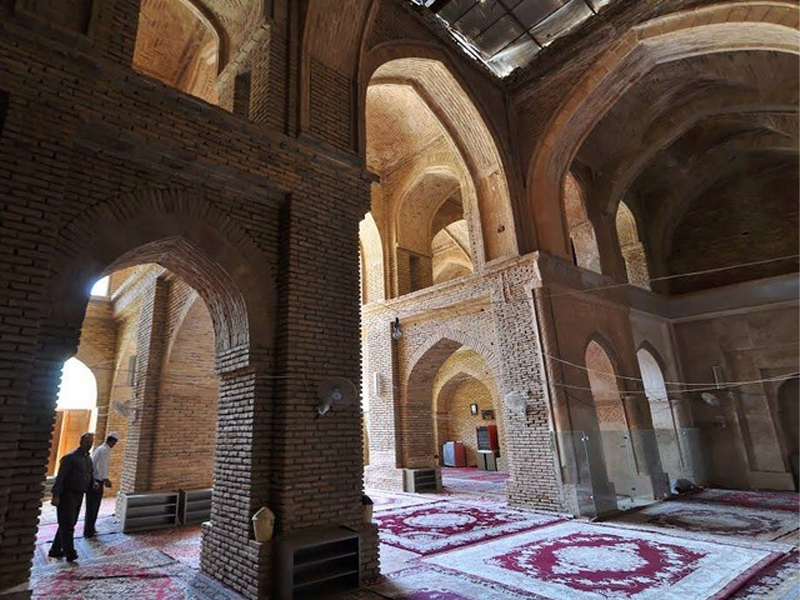
The White Dome or the Ravaq Mosque
This building, also known as the “Sardar Mosque” or the “Ravaq Mosque,” was built by Sultan Sanjar Seljuqi in 633 AH, and seventy years later, parts were added to it by Malik Ghiyas al-Din Muhammad Kurt.
Ancient Mosque
The Ancient Mosque is located in the southern part of the Gonbadkhaneh and is believed to have been a congregational mosque in the past. The space of this mosque includes a prayer hall and five porticos, and its structure is made of bricks with beautiful colorful tiles used in it.
Kermani Mosque
The Kermani Mosque is one of the most beautiful sections of the mausoleum and is considered a masterpiece of Islamic architecture. The builder of this mosque is famous by the same name, and the structure includes a porch and a royal seat. the entrance features a beautifully adorned vestibule with intricately decorated muqarnas. These muqarnas are skillfully painted with delicate floral and botanical motifs. Inside Kermani mosque, the tranquil space of Sheikh Ahmad Jami’s tomb encompasses an area of approximately 182 square meters. The structure includes a central royal chamber surrounded by four smaller spaces situated in the corners. Among them, the one in the southeast corner, known as the “Chelleh Khaneh,” serves as a place for individual worship and seclusion in the eastern and western sides.
Holy Stone
When you walk from the street towards the mausoleum, you will initially see a stone path on the left side, which many, especially locals, believe that Sheikh Ahmad Jami, after 18 years of seclusion, walked from this stone to his tomb. Therefore, this stone is held in special respect.
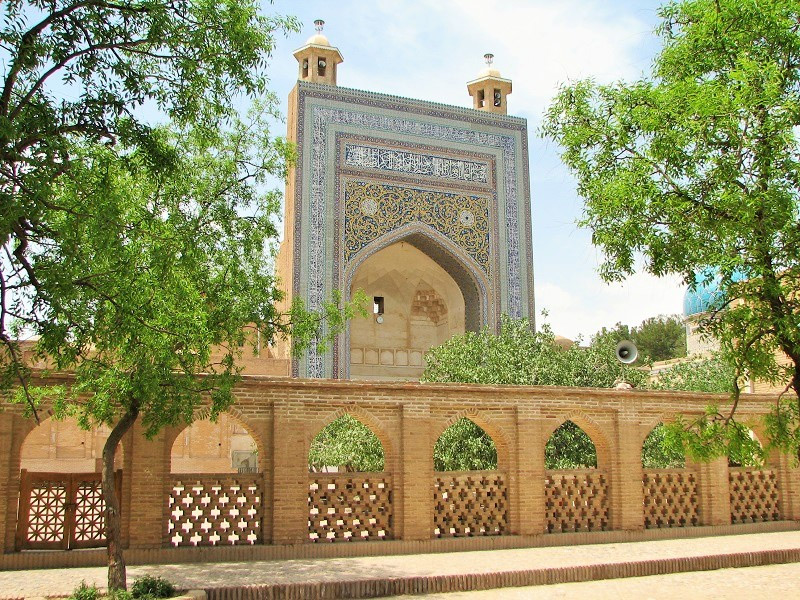
Water Reservoir
Adjacent to the entrance gate of the mausoleum of Sheikh Ahmad Jami, there is a brick water reservoir that, according to the available inscriptions and historical evidence, was built in 1010 AH by “Firooz Jang ibn Hussein,” one of the notables of the Safavid era. It served as a shelter and resting place for travelers, pilgrims, and devotees of Sheikh Jami.
The Firuzshahi Dome
The Firuzshahi Dome, also referred to as the “Green Dome” or the “Amir Jalaluddin Firuz Shah School,” holds a prominent position overlooking the serene courtyard of Sheikh Jami’s mausoleum. With its Chahar Taqi (four iwans) layout and an elegant dome crowning its structure, this architectural marvel epitomizes beauty and grandeur. Moreover, the dome chamber with its four Shah-Neshins and two portal-shaped Taq gracefully adorns the eastern and western sections. Adorned with vibrant tilework, this dome is a sight to behold.
Places of Interest around the Mausoleum of Sheikh Ahmad Jami
The mausoleum of Sheikh Ahmad Jami in Torbat-e Jam is one of the important historical sites in this region and has many interesting places around it. Around the mausoleum, one can mention the tomb and mosque of Khwaja Azizollah, the underground mosque, the Kermani Mosque, and the new Jame mosque. In addition, the local markets near the mausoleum provide a great opportunity for shopping and experiencing local activities. Furthermore, the traditional architecture and beautiful surroundings in this area are other attractions that attract travelers.
Related post
Mashhad Train: The Ultimate Guide to Traveling on the Mashhad Rail Route
Introducing the best restaurants in Mashhad
Access to the Mausoleum of Sheikh Ahmad Jami
The Mausoleum of Sheikh Ahmad Jami is located in the Razavi Khorasan Province, in the city of Torbat-e Jam, in the Saadabad neighborhood, approximately 166 kilometers away from the city of Mashhad. Access to the Mausoleum of Sheikh Ahmad Jami is easily possible from Jami Street, next to Sheikh Jami Park.
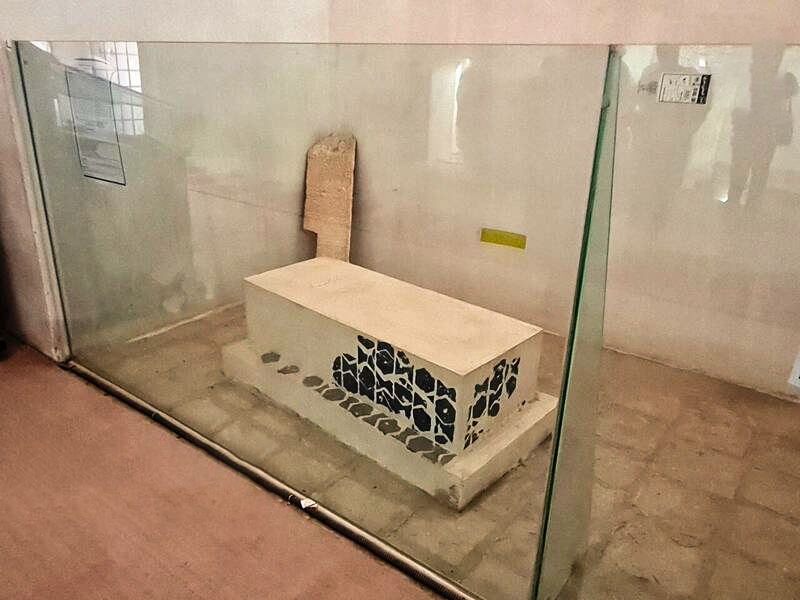
Final Words
With its beautiful architectural design and its historical and cultural values, the Mausoleum of Sheikh Jami has always been of interest to the people and researchers as a symbol of Islamic efforts and values in the region. Due to its cultural and religious significance, this mausoleum continues to play a significant role in Islamic teachings, the promotion of local culture, and the hospitality of visitors. It holds a special place in the culture and history of the region, leaving a lasting memory in the hearts of culture and history enthusiasts.
FAQ
1- Who was Sheikh Ahmad Jami?
Sheikh Ahmad Jami was a prominent Islamic scholar, poet, and mystic who lived during 1000 AD. He is known for his contributions to Sufism and Persian literature, particularly his famous work, “Baharistan” (The Garden of Spring).
2- Where is the Mausoleum of Sheikh Jami located?
The Mausoleum is located in the Saadabad neighborhood of Torbat-e Jam, in the Razavi Khorasan Province of Iran. It is approximately 166 kilometers away from the city of Mashhad.
3- What is the significance of the Mausoleum of Sheikh Jami?
The mausoleum holds great historical and cultural significance. It is considered a symbol of Islamic efforts and values in the region. It serves as an important center for Islamic teachings, the promotion of local culture, and as a place of hospitality for visitors.
4- What is the architectural style of the Mausoleum of Sheikh Jami?
The Mausoleum of Jami showcases beautiful architectural design. It combines elements of Persian Islamic architecture, with intricate tilework, arches, and domes. The overall design reflects the artistic and aesthetic sensibilities of the time.
5- Are there other attractions near the Mausoleum of Jami?
Yes, there are several other notable attractions near the mausoleum. These include the tomb and mosque of Khwaja Azizollah, the underground mosque, the Firuz Shahi dome, the Kermani Mosque, and the new Jame mosque. Additionally, local markets in the vicinity offer opportunities for shopping and experiencing local activities.
